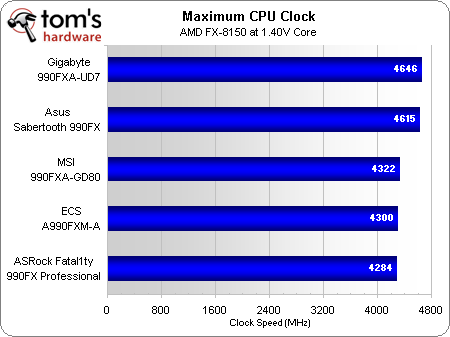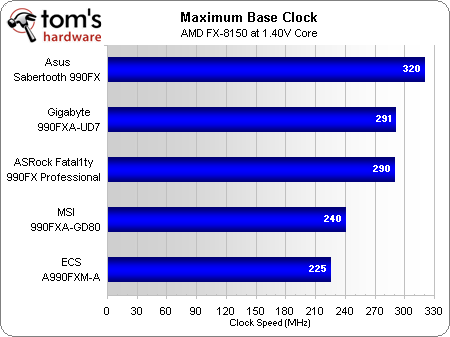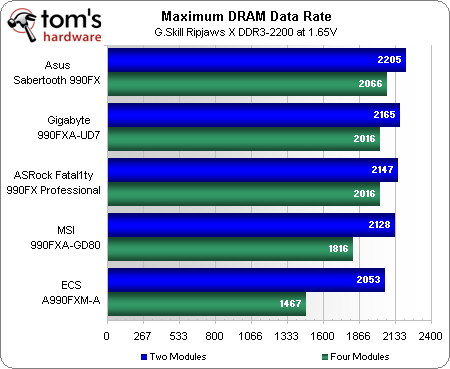Five $160 To $240 990FX-Based Socket AM3+ Motherboards
Forty-two PCIe lanes give the 990FX a clear connectivity lead over competing Intel chipsets. We compare five class-leading products using AMD's FX-8150 to see which offers the best combination of performance, overclocking, integrated features, and value.
Overclocking
| BIOS Frequency, Voltage and Timings | |||||
|---|---|---|---|---|---|
| ASRock Fatal1ty 990FX Professional | Asus Sabertooth 990FX | ECS A990FXM-A | Gigabyte 990FXA-UD7 | MSI 990FXA-GD80 | |
| Reference Clock | 150-500 MHz (1 MHz) | 100-600 MHz (1 MHz) | 190-400 MHz (1 MHz) | 200-500 MHz (1 MHz) | 190-690 MHz (1 MHz) |
| CPU Multiplier | 8.0-31.5x (0.5x) | 4.0-35.0x (0.5x) | 2.5-23.5x (0.5x) | 7.0-35.0x (0.5x) | 4.0-32.5x (0.5x) |
| DRAM Data Rates | 800-1866 (266.6 MHz) | 800-2400 (266.6 MHz) | 667-1866 (266.6 MHz) | 667-1866 (266.6 MHz) | 800-1866 (266.6 MHz) |
| CPU Vcore | 0.60-2.00V (12.5 mV) | 0.68-2.08V (6.25 mV) | +0 to +500 mV (50 mV) | -0.06 to +0.60V (25mV) | 1.08-2.05V (~10.5 mV) |
| CPU NB | 0.60-2.00V (12.5 mV) | 0.50-1.90V (6.25 mV) | Not Adjustable | -0.06 to +0.60V (25mV) | 1.00-1.82V (~11mV) |
| 990FX Voltage | 1.11-1.66V (10 mV) | 0.80-1.51V (6.25 mV) | +0 to +500 mV (10 mV) | 0.87-1.98V (5 mV) | 0.96-1.39V (~5.5 mV) |
| DRAM Voltage | 1.25-2.07V (10 mV) | 1.20-2.50V (6.25 mV) | -30 to +600 mV (10 mV) | 1.03-2.14V (5 mV) | 1.20-2.45V (~7 mV) |
| CAS Latency | 5-14 Cycles | 5-19 Cycles | 5-14 Cycles | 5-14 Cycles | 5-14 Cycles |
| tRCD | 5-19 Cycles | 2-19 Cycles | 5-19 Cycles | 2-19 Cycles | 2-19 Cycles |
| tRP | 5-19 Cycles | 2-19 Cycles | 5-19 Cycles | 2-19 Cycles | 2-19 Cycles |
| tRAS | 15-40 Cycles | 8-40 Cycles | 10-35 Cycles | 8-40 Cycles | 8-40 Cycles |
All enthusiast-grade motherboards provide a wide enough range of voltage controls to fry our processor, and a wide-enough range of frequencies to make our processor completely unbootable, even before we have a chance to fry it. Yet, our tests target long-term stability, and that’s why we choose a maximum 1.40 V at the CPU core for our overclocking efforts.
Gigabyte leads Asus in maximum CPU overclock, but we still preferred overclocking with the Asus Sabertooth 990FX due to its ability to set a target voltage in firmware. The 990FXA-UD7 forces us to chase the appropriate voltage by increasing core offset and retesting until the desired voltage level is achieved.
ECS appears to beat ASRock, but we were not able to do this with firmware. Because AMD Turbo Core was always enabled, getting a consistent clock required the use of AMD Overdrive. We further had to make adjustments in Overdrive at every reboot, making the 4.30 GHz clock rate unacceptably cumbersome to use.
MSI’s low score was caused by voltage drop that resulted from MSI’s voltage compensation mechanism removed from its first AMD Bulldozer firmware.
The Sabertooth 990FX achieves the highest CPU reference clock, which is a setting that achieves its greatest significance when used to overcome the limits of locked multipliers (which, incidentally, none of the FX processors suffer from). MSI’s apparent misfortune is caused by boot failures whenever we attempted to manually lower its CPU-NB ratio, which climbed past the edge of stability in “Auto” mode as we pushed up the CPU base clock.
Asus must not have gotten the message that AMD’s FX has no DDR3-2133 ratio, as this is the setting it uses to achieve a class-leading DDR3-2205 data rate. Gigabyte forces us to make our push from the DDR3-1866 ratio by increasing reference clock, and both Gigabyte and MSI even drop that capability with four modules installed.
Get Tom's Hardware's best news and in-depth reviews, straight to your inbox.
Current page: Overclocking
Prev Page Power, Heat, And Efficiency Next Page Which 990FX Board Should You Buy?-
timbo1130 How is this relevant to enthusiast? Bulldozer is out classed by Sandy Bridge I don't care if there are a few less sata ports. If you need to upgrade your better off going with Sandy bridge and z68 or p67 or wait for SB-E and X79.Reply -
julianbautista87 thanks for this article. I was waiting for it since some guy said that the 8150 was performing badly because of the mainboard used, but now I see that that was not correct.Reply -
_Pez_ Yeah If were to buy this boards would be with a Phenom real 6 core CPU 1100T :D that is the smartest choice. I think.Reply -
frostweaver I would wait till next year to decide. I still feel that windows 7 aint optimized for BD.Reply -
Tijok First off, thanks for the great article, good to see Tom's is keeping up the top notch quality!Reply
Secondly, I would really like to see a piece on extreme CFX/SLI configurations on rigs like this. It seems an article with reliable information on this would be beneficial to gaming enthusiasts, IT professionals, and HPC builders alike!
Hope to see an article along these lines soon! -
palladin9479 I bought the Sabertooth during the summer and I can attest to how amazing that board is. It's really nice, lots of features and high quality. I'm running a Phenom II X4 970BE @ 4.3Ghz on water right now. Absolutely wonderful system.Reply -
ta152h What a bunch of pretzel logic we have in this article.ReplyOf course, a fan of Intel's work could argue against the need for 42 lanes of second-gen PCIe when the 36 native to X58 Express support multi-card graphics configurations just as capably. But such a comparison really isn't necessary. After all, we've known for almost a year that Intel’s lower-cost Sandy Bridge-based part outperform the pricey six-core Gulftown-based processors in many desktop benchmarks, including pretty much every gaming scenario we throw at the two platforms.
So, x58 is irrelevant, because SB beats it. Except AMD's offering is somehow relevant even though both x58 and SB beat it. What?????
If you ignore x58 because SB offers better performance, you ignore anything AMD has because a SB setup offers better performance. If you want 36 or less lanes, x58 still offers better processors than you can hope to get from AMD. Bizarre logic.
Not that AMD is irrelevant, just the logic is badly flawed.



